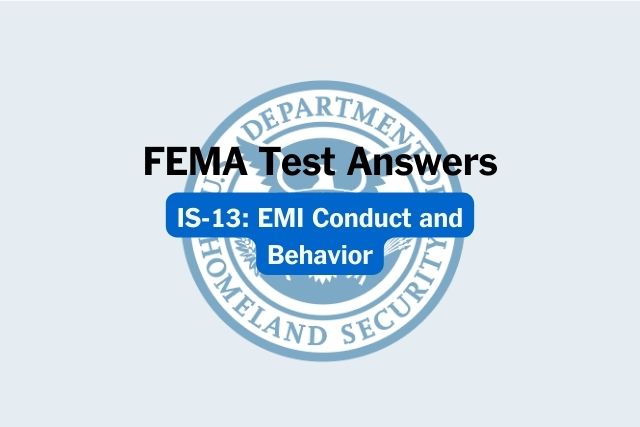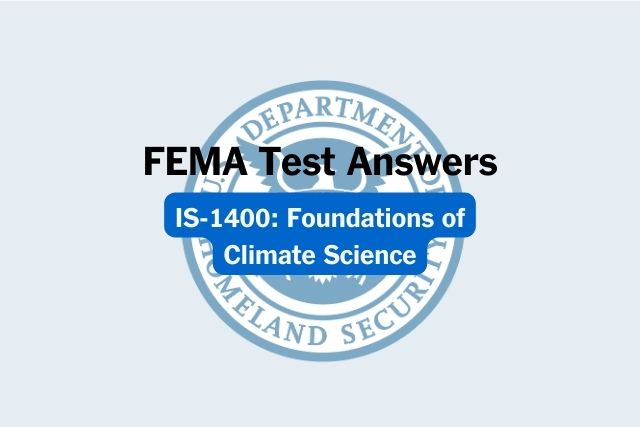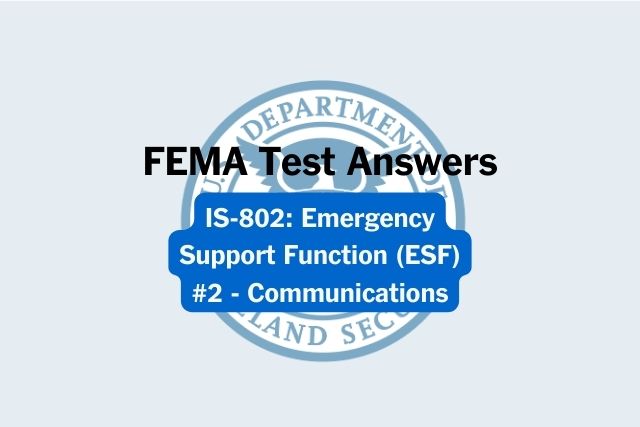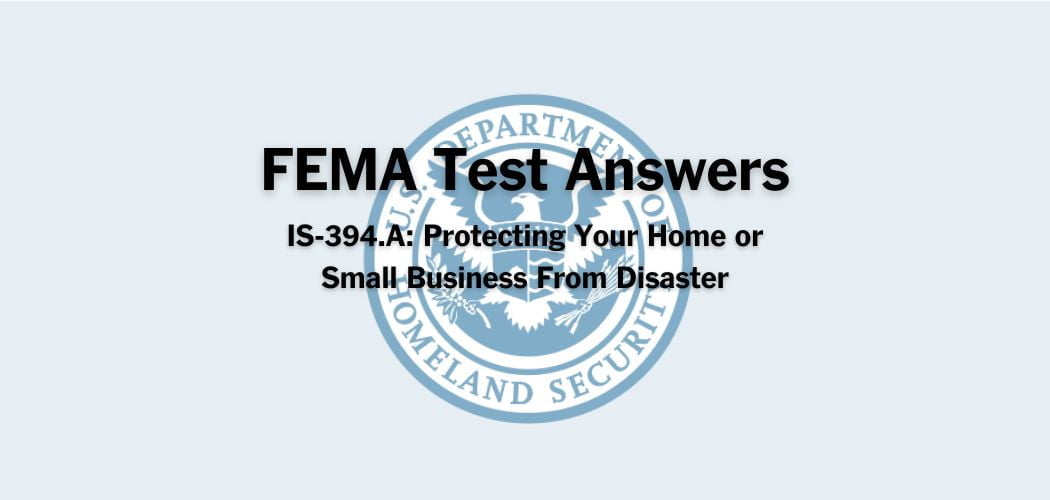Overview: The FEMA IS-1110.A course was published on 5/11/2016 to provide an introduction to commercial exposures and how they are insured within the National Flood Insurance Program (NFIP).
Primary audience: The IS-1110.A is an independent study is for property and casualty agents. It’s recommended to take the IS-1101: Basic Agent Tutorial first.
FEMA IS-1110.A test answers
Each time this test is loaded, you will receive a unique set of questions and answers. The test questions are scrambled to protect the integrity of the exam.
Question 1. Which of the following is an Other Residential building in the NFIP?
A. A hospital
B. A grain silo
C. A duplex home
D. An assisted living facility✅
Question 2. The maximum available contents limit for all non-residential buildings is:
A. $50,000
B. $100,000
C. $250,000✅
D. $500,000
Question 3. Which one of the following is NOT one of the five Additions and Extensions connectors in the Standard Flood Insurance Policy?
A. A rigid exterior wall
B. A patio✅
C. An elevated walkway
D. A roof
E. A stairway
Question 4. A mixed-use building is classified as a non-residential building if it is less than _______ residential.
A. 25%✅
B. 50%
C. 75%
D. 80%
Question 5. The General Property Form applies only to non-residential buildings.
A. TRUE✅
B. FALSE
Question 6. Condominium buildings that are at least 75% residential are written on the:
A. Condominium Master Form
B. Commercial Property Form
C. Residential Condominium Building Association Policy✅
D. General Property Form
Question 7. The maximum limit of coverage for a 100-unit residential condominium building written under the Residential Condominium Building Association Policy is:
A. $25 million
B. $50 million
C. $75 million
D. $100 million✅
Question 8. The Special Limits clause limits coverage for artwork, jewelry, furs, collectibles, and other named valuable items to:
A. $1,500
B. $2,500✅
C. $3,500
D. $4,500
Question 9. The maximum deductible option for all non-residential buildings is:
A. $5,000
B. $10,000
C. $25,000
D. $50,000✅
Question 10. The maximum available building coverage limit for all non-residential buildings is:
A. $50,000
B. $100,000
C. $250,000
D. $500,000✅
Question 11. Commercial condominium unit owners can purchase building coverage up to a maximum of:
A. $0. Building coverage may not be purchased in the name of the unit owner.
B. $250,000
C. $500,000✅
D. $1,000,000
Question 12. Pollution damage is limited in the General Property Form to:
A. $10,000✅
B. $50,000
C. $100,000
D. $500,000
Question 13. The Standard Flood Insurance Policy is always primary, and any other policy that includes flood coverage on the same building is excess.
A. TRUE✅
B. FALSE
Question 14. The Residential Condominium Building Association Policy is the only Standard Flood Insurance Policy form without a coinsurance clause.
A. TRUE✅
B. FALSE
Question 15. A nursing home is classified as:
A. A residential building
B. A habitational building
C. A non-residential business building
D. Another non-residential building✅
Question 16. The General Property Form and the Residential Condominium Building Association Policy automatically include contents coverage.
A. TRUE
B. FALSE✅
Question 17. Losses on all non-residential buildings are settled on an Actual Cash Value basis in the NFIP.
A. TRUE
B. FALSE✅
Question 18. The maximum available contents limit for an Other Residential building is:
A. $50,000
B. $100,000✅
C. $250,000
D. $500,000
Question 19. Which of the following contents item is covered under the General Property Form?
A. A watercraft
B. An aircraft
C. A swimming pool
D. A bathroom hot tub✅
Question 20. The Standard Flood Insurance Policy offers a blanket coverage limit for a policy with multiple buildings located in various states around the country.
A. TRUE
B. FALSE✅
Question 21. Which of the following is a Standard Flood Insurance Policy form used to write a commercial building with less than 75% of its floor area in residential use?
A. The Dwelling Form
B. The Commercial Property Form✅
C. The Residential Condominium Building Association Policy
D. The General Property Form
Question 22. The maximum deductible option for an Other Residential building is:
A. $5,000
B. $10,000
C. $25,000✅
D. $50,000
Question 23. Non-residential condominium buildings can be insured for up to $500,000 times the number of units in the building.
A. TRUE
B. FALSE✅
Question 24. Which of the following is an example of an ineligible risk in the NFIP?
A. An open stadium✅
B. A detached garage
C. A pole barn with two walls and a roof
D. A grain silo
Question 25. The actions that Increased Cost of Compliance coverage will pay for to bring a flood-damaged building into compliance are:
A. Elevating, Restoring, Floodproofing, Demolishing
B. Elevating, Relocating, Floodproofing, Demolishing✅
C. Elevating, Relocating, Floodproofing, Dismantling
D. Escalating, Removing, Floodproofing, Demolishing
Question 26. Other Residential buildings and all non-residential buildings are always covered under the General Property Form.
A. TRUE
B. FALSE✅
Question 27. To meet the NFIP’s “single building” definition, the building must be:
A. Separated from other buildings by intervening clear space
B. Separated into divisions by solid, vertical, load-bearing walls✅
C. Solid, vertical, load-bearing walls must divide the building from its lowest level to its highest ceiling
D. All of the above
E. None of the above
Question 28. A 5-unit rooming house with a normal guest occupancy of six months or more is an Other Residential building.
A. TRUE✅
B. FALSE
Question 29. Cooperative buildings are written using the General Property Form.
A. TRUE
B. FALSE✅
Question 30. Coverage for a tenant’s improvements and betterments is limited to_______ of the policy’s contents limit.
A. 5%
B. 10%✅
C. 20%
D. 50%
Question 31. Retail stores, banks, movie theaters, restaurants, and gas stations are all examples of non-residential business buildings in the NFIP.
A. TRUE✅
B. FALSE
Question 32. The Preferred Risk Policy is not available for any commercial exposure.
A. TRUE
B. FALSE✅
Question 33. The maximum available building coverage limit for an Other Residential building is:
A. $50,000
B. $100,000
C. $250,000✅
D. $500,000
Question 34. Commercial contents in a residential building can be covered under the General Property Form.
A. TRUE✅
B. FALSE
Question 35. Under the General Property Form, if the policy covers “other than household personal property,” coverage is included except for?
A. Furniture & fixtures
B. A guest’s personal property✅
C. Stock
D. Machinery & equipment
Question 36. The Standard Flood Insurance Policy provides business interruption coverage up to the policy’s Coverage C limit.
A. TRUE
B. FALSE✅
Question 37. If building coverage is purchased by a tenant due to a lease agreement:
A. The building owner cannot be named on the policy
B. The tenant cannot be named as an additional insured
C. The building owner must be named on the policy✅
D. The building owner and tenant may each write separate policies to cover the building



